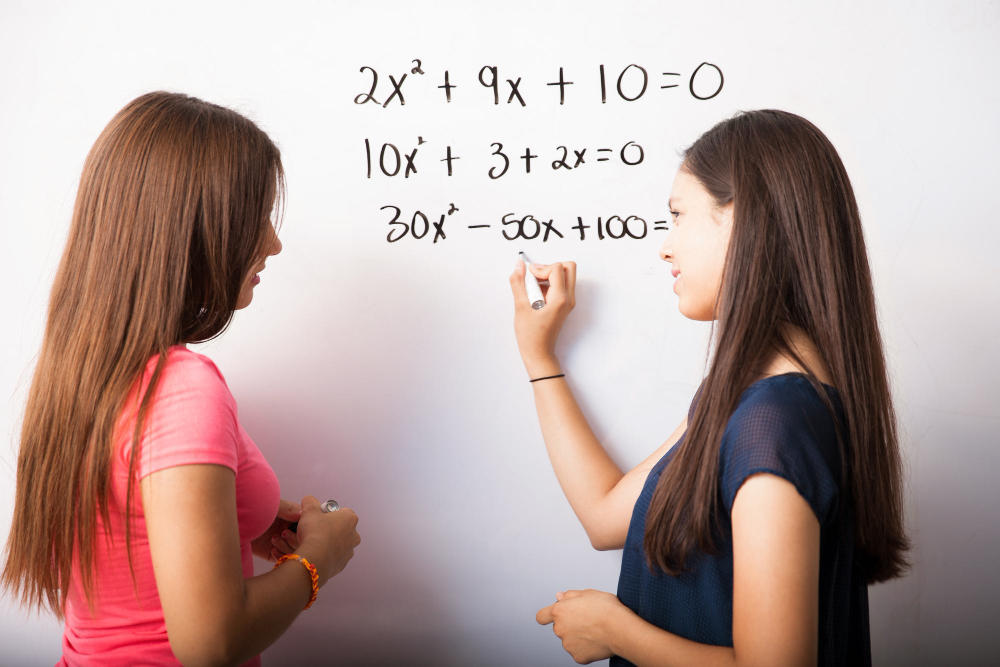Do you know what's one of the most effective ways to solve a big problem?
By breaking it into smaller problems.
As Form 6 students, you might be taken aback when you're told that there are a total of 18 chapters to cover for your STPM Maths T subject, for instance.
But what if I told you that you have three semesters to learn them and only be tested on 6 topics each semester? It does take some burden off your shoulders, right?
In this article, we will discuss the STPM Maths T syllabus for each term and the latest examination format for this subject.

Topics Covered In Term 1: Algebra and Geometry
Throughout the three semesters, you will learn a total of 18 chapters (6 chapters per semester).
Here are the six chapters that you will study during your first semester.
- Chapter 1: Functions [28 teaching period]
In this chapter, you will be taught polynomial and rational functions, exponential and logarithmic functions, as well as trigonometric functions.
- Chapter 2: Sequences and Series [18 teaching period]
In this chapter, you will be taught on core principles and formulas of sequences and series as well as binomial expansions.
- Chapter 3: Matrices [16 teaching period]
In this chapter, you will learn about various operations revolving matrices as well as different systems of linear equations.
- Chapter 4: Complex Numbers [12 teaching period]
In this chapter, you will learn about what are real and imaginary parts of complex numbers, how to present an Argand diagram, perform elementary operations for complex numbers and also apply de Moivre’s theorem.
- Chapter 5: Analytic Geometry [14 teaching period]
In this chapter, you will master the methods to transform a given equation of a conic into the standard form and find the vertex, focus and directrix of a parabola, ellipse and hyperbola.
- Chapter 6: Vectors [20 teaching period]
In this chapter, you will learn about vectors in two and three dimensions as well as various elements of vector geometry.
Learn more about the advantages that you can gain when you learn and master STPM Maths T as a Form Six student.

Image by tonodiaz on Freepik
Topics Covered In Term 2: Calculus
Now, let's move on to the second semester.
Here is the breakdown of sub-topics that will be covered in the following six chapters under the theme of calculus.
- Chapter 7: Limits and Continuity [12 teaching period]
In this chapter, you will learn how to determine the existence and values of the lefthand limit, right-hand limit and limit of a function; the continuity of a function at a point and on an interval; and also apply the intermediate value theorem.
- Chapter 8: Differentiation [28 teaching period]
In this chapter, you will learn to master sub-topics like derivatives and different applications of differentiations.
Furthermore, you'll learn how to perform implicit differentiation, determine the stationary points, extremum points and points of inflexion; find the equations of tangents and normals to curves, including parametric curves and many more.
- Chapter 9: Integration [28 teaching period]
In this chapter, you will be taught about different sub-topics like indefinite integrals, and definite integrals.
You will learn how to integrate rational functions by means of decomposition into partial fractions, perform integration by parts; calculate the area of a region bounded by a curve (including a parametric curve) and many more.
- Chapter 10: Differential Equations [ 14 teaching period]
In this chapter, you will learn about first-order differential equations with separable variables, first-order linear differential equations utilizing an integrating factor and how to use a boundary condition to find a particular solution.
At the end of this chapter, you will master the skill to solve problems that are related to science and technology which can be modelled by differential equations.
- Chapter 11: Maclaurin Series [12 teaching period]
In this chapter, you will learn how to determine the Maclaurin series for a function and the interval of convergence.
You will also learn the difference between standard series and power series as well as how to use series expansions to find the limit of a function.
- Chapter 12: Numerical Methods [14 teaching period]
In this chapter, you will learn about the numerical solution of equations and numerical integration.
Some of the learning outcomes under the subtopic of numerical solution of equations include locating the root of an equation approximately using graphical considerations and searching for a sign change and many more.
Under numerical integration, you will learn how to use the trapezium rule and sketch graphs to determine whether the trapezium rule gives an overestimation or an underestimation in simple cases.
Dive deep into these tips to score well for your STPM Maths T papers.

Topics Covered In Term 3: Statistics
We've arrived at our final semester for your STPM Maths T syllabus.
Similarly, you will be taught 6 chapters.
- Chapter 13: Data Description
In this chapter, you will study discrete, continuous, ungrouped and grouped data, and expand on the concepts of mode, median and interquartile range based on what you have learned during your SPM studies.
You will also learn more about the appropriate measures of central tendency and measures of dispersion and apply the Pearson coefficient of skewness.
- Chapter 14: Probability
Apart from learning about the addition and multiplication principle of various probability operations, you will also learn how to calculate conditional probabilities and identify independent events in this chapter.
- Chapter 15: Probability Distributions
In this chapter, you will study the properties and direct application of discrete random variables, continuous random variables, binomial distribution, Poisson distribution and normal distribution.

Photo by Naser Tamimi on Unsplash
- Chapter 16: Sampling and Estimation
In this chapter, some of the major learning outcomes that you will master include learning the differences between a population and a sample, and between a parameter and a statistic as well as determining and interpreting a confidence interval for the population mean based on a sample from a normally distributed population with known variance.
- Chapter 17: Hypothesis Testing
In this chapter, you will learn how to explain what a hypothesis and alternative hypothesis are, as well as the significance level of a test. You will also master the ability to carry out various hypothesis tests for different samples.
- Chapter 18: Chi-Squared Tests
In this chapter, you will learn how to use the chi-squared distribution tables and identify the chi-squared statistic.
From there, you will get to apply the goodness of fit test and test of independence for different problems.
Latest Exam Format For The STPM Mathematics T Written Test
After reviewing all the topics that will be covered for your STPM Maths T subject, let's now look at the examination structure for your assessments.
Every semester, candidates will sit for one written test. It is a central assessment and the test duration is 1 hour and 30 minutes.
There are two sections for each STPM Maths T written test.
Section A
For Section A, candidates have to answer 6 questions of variable marks. The total mark for section A is 45 marks.
Section B
For Section B, candidates can choose from two question options. The total mark for section B is 15 marks.
The full mark for each written test is therefore 60 marks, which will be rounded up to 26.67% in terms of weightage to calculate the overall grade for your STPM Maths T subject.
Don't forget to look through these amazing learning resources for your STPM Maths T papers.
Enhance Your STPM Maths T Revision Journey With A Superprof Tutor
Since you'll be preparing for a written test that involves different topics each semester, it could be an overwhelming process.
Instead of going through the revision journey all by yourself, why not study the STPM Maths T subject under the guidance of an experienced Maths tutor?
With Superprof, you can find a reliable Maths tutor who can help you strengthen your comprehension of all the taught topics for each semester consistently.
That way, you don't have to worry about the lack of preparation or the lack of practice before sitting for the actual exam. You can also master the marking rubrics of your STPM Maths T papers.
Not only that, you also get to enjoy a flexible learning experience because you can opt to learn from a home tutor or online tutor with the help of Superprof.
Visit the Superprof Malaysia homepage to kickstart your STPM Maths T revision journey today.
Overview Guideline For STPM Mathematics T Coursework
Apart from your written test, you will also need to complete three assignments (coursework) throughout the three terms.
Unlike your written test, your coursework assessment will be graded by your subject teacher. Each semester, you will be given a different assignment task (based on the taught topics that semester).
You need to come out with a written report and undergo a viva session to receive your grade.
What Should Be Included In Your Complete Written Report Each Semester
Read the following information carefully as you prepare your report.
Don't forget to print out and complete the declaration statement and attach it to your report before the final submission.
The total mark allocation for your report is 40 marks.
- Introduction
Include the title of the report and describe the problem in your introduction.
- Methodology
Write down the application of appropriate methods to address the given problem. You should also list the collection of relevant data and information under this section.
- Results
You should include mathematical calculations and the final results with mathematical reasoning. Based on that, you should also interpret your results systematically.
- Conclusion
You should discuss and summarise the outcomes of your assignment report.

Image by jcomp on Freepik
Things To Take Note For Each Viva (Presentation) Session
The complete mark for your viva session is 20 marks.
- Understanding of the assignment
You need to provide complete and accurate explanations alongside critical discussion using appropriate terminology based on your assignment report.
- Communication
You should present the relevant explanations and examples clearly and effectively.
Important tip: Be calm and confident during the Q and A session after presenting your points.
We hope you have gained a new understanding towards the overall syllabus and examination format for your STPM Maths T subject through this article.
All the best!
























